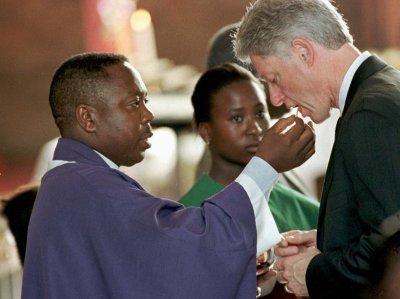

President Clinton took Communion at Mass in a Catholic church in Soweto yesterday and listened as the priest preached a sermon on adultery.
Mr. Clinton spent almost two hours at the end of his four-day visit to South Africa in the packed Regina Mundi church in Johannesburg's Soweto township, before going to Botswana, where he arrived as part of an African tour.
The church was a focal point of black resistance to apartheid before white minority rule ended with elections in 1994. Mr. Clinton was given a rousing welcome by the 1,000-strong ululating and whistling congregation as he entered the church to the strains of America the Beautiful played on the organ.
"I am honoured to be here in this great shrine of freedom," Mr. Clinton said after the Mass. "I came to South Africa first to thank God that you have your freedom now. Also, I came here resolved to work with the people of South Africa to help you make the most of your freedom."
The U.S. President, a Baptist, took Holy Communion at the Mass as a result of a decision by the South African Catholic Bishops' Conference permitting him to do so.
Father Mohlomi Magubane chose as the subject for his sermon the account of an adulterous woman who was saved being stoned to death by Jesus Christ, who challenged her accusers, saying one without sin should cast the first stone.
At home, Mr. Clinton is up against allegations of sexual misconduct.
The President, with his wife Hillary and a delegation of visiting US officials, looked relaxed and acknowledged the crowd as he entered. But he became visibly uncomfortable when the priest, Father Makobane, read from John 8: 1-11. Mr. Clinton looked sombre and rocked on his heels as the priest read the text. Mrs. Clinton's head was bowed throughout the reading.
"There may be amongst us many . . . who may feel unworthy," Father Makobane said in a sermon after the reading.
"Here was a woman who people said committed adultery, but Jesus said go and sin no more," he said.
"Many times we find ourselves being caught up hiding our love from the public . . . But we have to know that God is love. And this love which is God himself is the love to the world . . . the love to Africa, or Latin America . . . that all of us need to share."
"We are all sinners, but who are we to condemn?" said Father Magubane. "Here was a woman who had sinned, but Jesus said go and sin no more." Father Magubane praised Mr. Clinton for his own contrition over the US treatment of slaves and his admission that Washington had failed to act decisively to prevent the 1994 genocide in Rwanda.
Mr. Clinton sat three rows from the front of the packed, white-painted church, alongside his wife and the US black rights activist, the Rev Jesse Jackson, who is Mr. Clinton's special representative to Africa.
Afterwards, before taking his motorcade to Johannesburg airport, Mr. and Mrs. Clinton shook hands with a crowd of around 200 local residents who had waited eagerly outside the church during the two-hour Mass. Some 60 children sang and waved their arms. - (AFP, Reuters)
Chapter One: The Wafer-God
There are some Christians who are awake to what is going on, but there are many Christians today who believe everything is just fine. Everybody loves everybody else. The Christians, Mormons, Jews, Jehovah's Witnesses, Moslems are all serving the same God, but in different ways.
If I asked, "Can you partake of the Lord's Supper with Catholics?" They'd say, "Why not?" Let's find out if there is a difference between the Lord's Supper and the mass. Before I go on, let me explain that the bread, or wafer, used in the mass is called the host. When the host has been consecrated and offered as a sacrifice in the mass, it then becomes the eucharist. I am going to try to put into everyday language what is one of the great motivating forces behind the Roman Catholic Institution. It is the eucharist. I call it the little Jesus cookie. I know Catholics are going to be offended by this, but I can't help it. The Protestants have to realize where they stand on this thing.
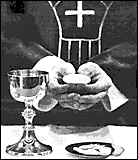
The Roman Catholic Institution in their Canon laws state:
If any one shall deny that the body and blood, together with the soul and divinity of our Lord Jesus Christ, and therefore entire Christ, are truly, really, and substantially contained in the sacrament of the most Holy Eucharist; and shall say that He is only in it as a sign, or in a figure, let him be accursed.
(Accursed means to be damned, under a curse).
If any one shall say that Christ, the only begotten Son of God, is not to be adored in the holy sacrament of the Eucharist,.... and that He is not to be publicly set before the people to be adored, and that His adorers are idolaters, let him be accursed
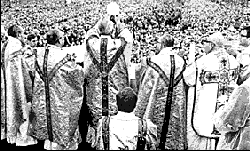
That's when, beloved, the priest walks out holding up the cookie in the monstrance, which looks like a sunburst, and people come up and kiss it and adore it. And if any Protestant would say, "Hey, that's idolatry," that Protestant is to be accursed.
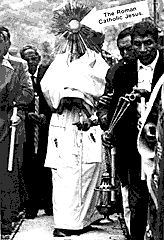
The eucharist in the monstrance being carried in a procession
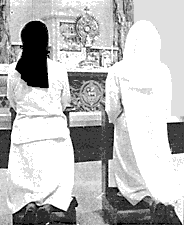
Perpetual Adoration - Two Benedictine Sisters at the Convent of Perpetual Adoration kneel before the Blessed Sacrament exposed in a monstrance in the convent chapel. Whether at work or at prayer, the nuns focus their lives on "Jesus" present in the eucharist.
Now, to sum this up, the Roman Catholic Institution teaches that you must believe that the bread, or host, consecrated in the mass actually becomes Jesus Christ and it is to be worshipped as God Almighty. This is why, back in 1554, a priest carrying the eucharist (the little Jesus cookie) could stand before a family of Christians in Scotland, tied to posts with dried brush up to their waists. He'd hold that piece of bread before them and ask if what he held in his hand was actually the body, blood and deity of Jesus Christ. When they said:
No, it is only a symbol
the priest's assistant placed his flaming torch into the brush and set those Bible-believers on fire. As the victims screamed in agony, the priest held up his crucifix and said:
All this is for the greater glory of God.
It holds firm, just as strong today, as it did in the time of the Dark Ages, that anyone who ridicules it, or says that it only represents Christ, is damned. The Vatican II Council re-affirmed this. Pope John XXIII said:
I do accept entirely all that has been decided and declared at the Council of Trent.
Excerpted from Smokesreens by Jack Chick.
When the novel doctrine of transubstantiation was first introduced in the year 831, the king of France summoned the great Irish Doctor Johannis Scotus Erigena to expose it. Here is a brief extract from the History of the Scottish Nation, Vol. III:
The year 831 is a memorable one in the annals of ecclesiological development. In that year an enormity, which four hundred years after came to bear the barbarous name of transubstantiation, had its first conception in the human mind. In 831 appeared the book of Paschasius Radbertus, a French monk, in which for the first time it was propounded to the world that the body of Christ in the sacrament is the very same which was born of the Virgin, and was nailed to the cross. The whole Western Church was astonished. The greatest theologians of the age declared the notion to be absolutely new, and offered it their most strenuous opposition. Nowhere was the repudiation of this stupendous novelty more emphatic than in the Scottish Church and her allied branches. In the front rank of its opponents were the Scoto-Irish divines, among whom was Johannis Scotus, Erigena, the founder of the University of Paris.
Scotus was then residing at the Court of Charles the Bald of France, and that monarch called upon him to enter the lists against Paschasius. The great Culdee scholar responded to the royal call, and wrote a book in condemnation of the revolting dogma, for so did the French Church of that age regard it. Another distinguished divine, Bertram by name, took part with Scotus in his war against the new and monstrous proposition. The book of Bertram, written in refutation of Paschasius, is still extant, and occupies a distinguished place with the Bible in the Index Expurgatorius of Rome. The work of Johannis Scotus had ultimately a different though a not less honourable fate. About two hundred years after, when the doctrine of transubstantiation, strengthening as the darkness deepened, began to make way in Germany and France, Berengarius stood forth as its uncompromising opponent. To maintain himself in the storm of persecution which his bold defense of the truth drew upon him, he appealed to the work of Scotus, as showing that his own views of the sacrament were those of the Church of the ninth century. This drew the tempest upon the book of Scotus without diverting it from Berengarius. The work of our countryman had the honour of being committed to the flames by order of Pope Leo IX., A.D. 1050. But its title has been preserved in the records of the age, and remains to this day to witness to the orthodoxy of the Scoto-Irish Church, and of the Church universal, on the head of the sacrament, till towards the opening of the tenth century. That title runs thus: The Sacraments of the Altar are not the real Body and Blood of Christ, but only the commemoration of His Body and Blood.'' 1
Nor does the use of the term "altar" on the part of the early church in the least assist the Romanist in his argument. It is admitted that the phrase often occurs in the records of early Christianity, but the question is as before, In what sense was the phrase used? History furnishes us with an answer which is beyond doubt. The "altar" of the early church was a wooden table. The "mass" of the early church was a commemorative offering or sacrifice of bread and wine, and the "priesthood" that stood around the table on which this sacrifice was laid were the Christian people, their worship being led by the officiating minister. We find no Roman dogma under the "altar" of the primitive church when historically interpreted. We can see neither sacrificial meaning nor expiatory virtue in the simple offering of bread and wine on the wooden table, transubstantiation and the mass being yet a great way off, and neither in the sight nor in the thought of the early church. All as yet is natural, simple, and spiritual. How absurd, then, is it for the Romanist to maintain that these terms were used by the early church as expressions or symbols of ideas and dogmas which were then, and for many centuries afterwards, unheard of in the world! And it is equally absurd to attempt fastening upon the Columban Church the belief of these undiscovered theological enormities, simply because she made use of the same phraseology when speaking of her religious services which was employed by the whole early church of Christ, that church being ignorant of what unthought-of things the future was to bring forth. It is a hard task, verily, which these reasoners impose upon themselves. We will not say that they are arguing with conscious absurdity; on the contrary, we willingly admit that they believe in the soundness of their position, for otherwise we cannot account for the persistence with which they press their view upon others, and of the boldness with which they maintain an argument which all outside their circle see to be preposterous.
Footnote
1 Dupin, Cent. ix. c. 7. Besides the title, a few extracts from the work of Scotus have been preserved, as for instance: "The things that take place at the altar are done in show, not in reality," Specie geruntur ista, non veritate,
Editors note
Bill Clinton is your typical Jesuit.